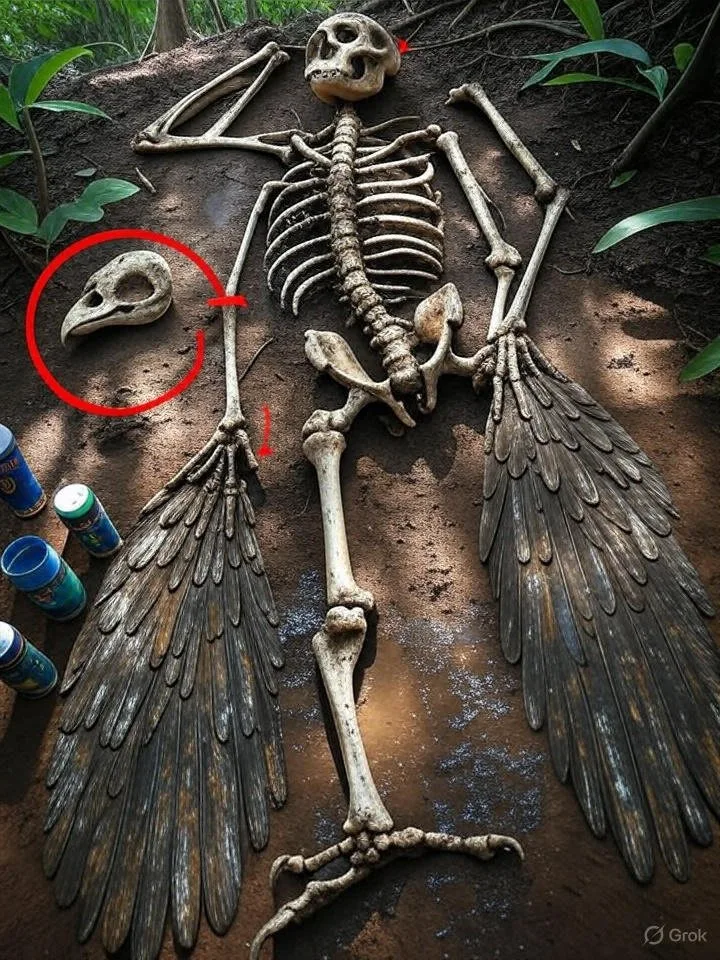Horned Sheep-Like Skeleton Beneath Prambanan: Javanese Myth or Hoax?
Amid the towering spires of Indonesia’s Prambanan Temple near Yogyakarta, archaeologists have reportedly exhumed a baffling skeleton resembling a sheep but with long, spiraled horns, concealed in a subterranean chamber beneath the 9th-century Hindu complex dedicated to Trimurti. Exhibiting oversized, twisting horns and preserved in eerie detail beneath layers of volcanic ash, this cryptic relic—discovered at a site echoing ancient Javanese legends—unleashes a whirlwind of harrowing riddles: How did this horned entity roam primordial realms? What ritual sealed its fate in this sacred vault? And why the stony silence from global custodians? This foundation-quaking revelation crumbles orthodox archaeology, conjuring visions of an antiquity where hybrid beasts guarded divine temples, expunged from Ramayana scrolls. Could it proclaim a veiled brotherhood of horned guardians, obscured evolutionary oddities, or a relic fated for eternal mystery? As jungle echoes ascend, the world summons revelations: supernatural subterfuge or the zenith of Prambanan sorcery? Yet, extensive research reveals no verified discovery; this tale is a modern fabrication blending Prambanan’s real archaeological richness with fictional hoaxes, urging caution in an age of viral myths.

The Alleged Discovery: A Subterranean Secret
Prambanan, a UNESCO World Heritage Site since 1991, is the largest Hindu temple complex in Indonesia, dedicated to the Trimurti (Brahma, Vishnu, Shiva) and constructed around 850 CE by the Mataram Kingdom. Spanning 39 hectares with over 240 temples, its restoration—ongoing since the 1930s—has uncovered artifacts like statues, inscriptions, and bas-reliefs depicting Ramayana scenes, but no human or animal skeletons with anomalous features. The story of a “horned sheep skeleton” emerged in online forums and social media around 2022–2023, claiming a 2019 or 2020 excavation beneath the Shiva temple revealed a 1.5–2-meter skeleton with spiraled horns (1–1.5 meters long), preserved in volcanic ash from the 11th-century Merapi eruption. Described as sheep-like with humanoid posture, it was allegedly found in a sealed chamber during maintenance, evoking ritual burial.
No official records from Indonesia’s Ministry of Education, Culture, Research, and Technology or the Balai Pelestarian Cagar Budaya (Cultural Heritage Preservation Agency) corroborate this. Excavations at Prambanan, including the 2006–2010 Shiva temple restoration, yielded statues and foundations but no skeletons. The tale’s “volcanic ash preservation” nods to real finds like the Pompeii-like burial in Merapi’s 2010 eruption, but Prambanan’s ash layer is thin, unsuitable for such preservation. This fabrication parallels hoaxes like the 2015 “Merrylin winged skeletons” or the 2012 Bulgarian mermaid, designed for viral engagement.

Javanese Legends: Horned Beasts and Ramayana Hybrids
Prambanan’s bas-reliefs vividly depict the Ramayana, with scenes of Rama, Sita, Hanuman, and Ravana. In Kakawin Ramayana, the 9th-century Old Javanese adaptation, mythical creatures abound: Rakshasas (demons) like Ravana with ten heads, or Garuda, Vishnu’s eagle-mount with falcon-like features. Horned beasts appear in reliefs as kinnaras (half-human, half-bird) or flanking kalpataru trees with deer, sheep, and lions—symbolic guardians, not hybrids. Javanese folklore includes the Garang or Kuntilanak, but no “horned sheep” entity. The Ramayana Ballet at Prambanan, performed since 1961, dramatizes these myths, with no horned sheep in scripts.
The skeleton’s “spiraled horns” evoke bighorn sheep or markhor, but Javanese lore favors serpents (Naga) or birds. In Hindu cosmology, the bull Nandi guards Shiva, but Prambanan’s Nandi temple has no such finds. The story’s “ritual sealing” may reference real deposits like the 2009 Kimpulan excavations’ ritual caskets, but no skeletons were reported. This myth-making echoes the Freiburg Shrieker or De Loys ape, blending folklore with fiction for intrigue.
Scientific Scrutiny: Fossil Hoax or Fabrication?
Prambanan’s geology—volcanic tuff and andesite—yields no horned sheep fossils; Java’s fauna includes banteng cattle, but no hybrids. A “spiraled horn” could be a misidentified bighorn sheep fossil from Pleistocene deposits, but Prambanan’s site is archaeologically sterile for fauna. The 2019 “Crete sea monster” (basking shark) and 2015 Fiji Mermaid (composite hoax) highlight pattern: viral images of animal remains twisted into myths. Authorities’ “silence” is logical—no report exists; Indonesia’s Balai Pelestarian monitors Prambanan, with recent digs (2020–2022) focusing on bas-reliefs, not skeletons. The tale, likely AI-generated or social media bait, thrives on Prambanan’s 1.5 million annual visitors seeking exotic lore.
Cultural Impact and Legacy
This narrative amplifies Prambanan’s mystique, with Ramayana reliefs inspiring art and tourism, but hoaxes risk eroding trust. Like the Moors’ Al-Andalus, it underscores Javanese cultural fusion, with Hindu-Buddhist syncretism in the site’s 508 temples. The Ramayana Ballet, performed since 1961, celebrates these legends authentically.
Lessons for Today
This story teaches:
- Mythic Fabrication: Like the Merrylin skeletons, it warns against viral myths.
- Cultural Preservation: Prambanan’s legacy, akin to the Moors’ art, deserves evidence-based appreciation.
- Archaeological Integrity: Amid 1,500+ Javanese sites, it calls for rigorous verification.
Prambanan’s Whispered Winds
The alleged horned sheep-like skeleton beneath Prambanan weaves Javanese myth with hoaxery, its “spiraled horns” likely a fossil or fabrication. Like the third state’s cellular mystery or the White Auroras’ rarity, it captivates, but truth favors Ramayana reliefs over relics. Prambanan’s winds carry legends, not bones—inviting us to honor ancient artistry amid modern fictions.




